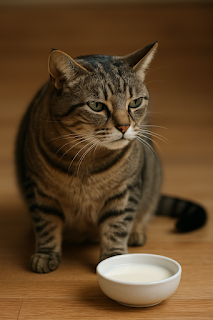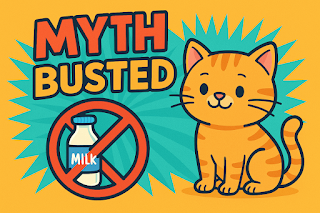Picture this: a fluffy kitten lapping up milk from a bowl with blissful abandon. It’s a scene straight out of a children’s storybook. But, is it true in real life, or is it just another charming myth that could actually harm your feline friend?
On today's MythBusting Monday, let’s bust the age-old dairy myth: Can cats really drink milk?
Let’s dive into the history, science, cultural psychology, One Health impact and animal welfare implications of this persistent dairy myth.
Myth: Cats love milk and it’s good for them.
This belief is so ingrained that even cartoons and movies show milk as the ultimate feline treat. But what if I told you that milk might be more villain than hero in your cat’s digestive saga?
Why Does This Myth Exist?
Historical Roots
- Farm Culture: On traditional farms, cats were kept for pest control. Milk was plentiful, and leftover unpasteurised milk or whey was often poured out. Cats naturally drank it, reinforcing the assumption that milk was good for them. No one noticed mild digestive upset or they deemed it insignificant compared to milk’s availability.
- Victorian Imagery: Paintings and stories from Victorian Europe romanticised cats as dainty creatures, often pictured with bowls of cream to evoke refinement and warmth in homes.
- Cartoons & Media: Mid-20th-century cartoons like Tom & Jerry and Disney animations cemented this imagery globally. Marketing campaigns by dairy industries capitalised on the concept that milk = nourishment for all, animals included.
Who Propagated It?
- Dairy Industry Campaigns: To promote milk as a staple health drink, advertisers used animals, children and strong adults as symbols of vitality. Cats drinking milk were depicted to highlight wholesomeness and domestic bliss.
- Media & Entertainment: Films, animations (Tom and Jerry) and children’s books reinforced the imagery without scientific scrutiny, embedding it as a “fact” in society’s subconscious.
Psychological & Cultural Propagation
These widespread media depictions didn’t just remain as external imagery, they seeped into how humans think and feel about feeding their pets. Seeing cats drink milk repeatedly in media shaped cultural beliefs by reinforcing two key psychological patterns:
Anthropomorphism: Humans tend to project their own dietary needs onto their pets. Since milk is seen as nourishing and comforting for people, it’s assumed the same applies to cats.
Visual Appeal: Images of cats drinking milk create a serene, affectionate scene. People are drawn to narratives that strengthen their identity as caring, nurturing pet owners.
In essence, the myth wasn’t only spread by advertisements and media; it became deeply anchored in society because of how humans interpret, relate to and emotionally respond to these images.
The Reality Check: Why Can’t Cats Drink Milk?
Lactose Intolerance
Most adult cats are lactose intolerant - Their bodies don’t produce enough lactase, the enzyme needed to break down lactose (milk sugar) into glucose and galactose for absorption. This means milk ends up fermenting in their guts, leading to:
- Diarrhoea
- Stomach cramps
- Gas
- Dehydration (ironically)
How Does it Happen: The Digestive Process
Kittens naturally produce lactase to digest their mother’s milk, but as they grow and wean onto solid food, lactase production decreases.
By adulthood, milk becomes more of a digestive nightmare than a treat. Adult cats cannot break down lactose efficiently, undigested lactose then passes into the large intestine where gut bacteria ferment it, producing gas, bloating and diarrhoea as unpleasant side effects.
Why Does it Happen?
- Evolutionary Design: Cats are obligate carnivores. Their natural diet does not include milk beyond weaning age. Evolution, therefore, did not retain high lactase production into adulthood.
- Taste vs. Tolerance: Cats may crave milk’s fat and protein flavour, but craving isn’t the same as digesting it safely - much like humans craving junk food that wreaks havoc on their bodies.
Why Are Cats Attracted to Milk?
Cats are often drawn to milk for several reasons:
- Fat content: The creamy texture and fat in milk, especially unpasteurised milk with its thick cream layer, activate their taste receptors for rich, fatty foods. Cats’ bodies are wired to seek out high-protein, high-fat foods, similar to the prey they would naturally hunt, like rodents and birds.
- Smell and Taste: Milk contains fats and proteins that release scents mimicking amino acids found in meat. Cats’ keen sense of smell picks up on these compounds, signalling that milk might be a nutritious food source.
- Warmth and Familiarity: When milk is served warm, it mimics the temperature of fresh prey or their mother’s milk, which may enhance its appeal.
- Novelty and Curiosity: For indoor cats fed a consistent commercial diet daily, milk can present a new taste and texture. Their natural curiosity, combined with the rich, creamy mouthfeel, makes it an irresistible “forbidden treat,” even if it isn’t beneficial.
The Argument That Sparked My Curiosity
When I was twelve, I was reading a comic where a cat drank milk straight from a bowl. I smiled and said, “Cats love milk.”
My friend beside me shook her head and said, “That’s not true. Milk makes cats sick.”
I laughed. “What do you mean? Every cartoon and story shows cats drinking milk. They love it.”
She insisted, “My aunt is a vet. She said most adult cats can’t digest milk. It gives them diarrhoea.”
We argued about it all break time. I thought she was just trying to sound smart, but her words bothered me. That evening, I went home and searched it up and to my shock, she was right.
That small argument sparked something in me. I realised that what we see in books and cartoons isn’t always true for animals. It was one of the moments that sparked my curiosity to always question and dig deeper when it comes to animal health.
Scientific Studies Debunking the Myth
- Clinical Observations: Vets observed consistent gastrointestinal symptoms (diarrhoea, bloating, flatulence) in cats given cow’s milk, leading to deeper examination of feline lactose intolerance.
- Digestive Physiology Studies: Comparative studies of lactase enzyme activity across species confirmed that adult cats have low or absent lactase levels, making lactose indigestible.
- Behavioural Studies: Trials assessing food preference found cats preferred meat-based or high-protein treats over milk if given a choice.
What Can Pet Parents Do?
- Stick to Water: Fresh, clean water remains the best and safest hydration source for cats.
- Focus on balanced nutrition: Feed them complete, high-protein cat food that meets their natural dietary needs.
- Use Cat Milk Formulas: If you really want to treat your cat, buy specially formulated lactose-free cat milk available at pet stores.
- Monitor Treats: Even lactose-free cat milk should only be an occasional treat, not a daily staple.
- For Orphan Kittens: Always use kitten formula milk, not cow’s milk. Cow’s milk can cause fatal digestive upset in newborn kittens.
- Offer safer alternatives: If commercial cat milk formulas aren’t accessible, consider:
- Diluted goat’s milk (lower in lactose)
- Homemade lactose-free milk (adding lactase drops to cow’s milk to pre-digest lactose)
- Bone broth (plain, unsalted, without onions or garlic)
- Water mixed with a little tuna juice (for flavour and encouragement to drink)
- Observe your cat’s reaction: Whenever introducing milk or any new food, watch closely for signs of digestive upset like diarrhoea, bloating, or vomiting, and stop immediately if these occur.
What Will the Vet Do?
If your cat has diarrhoea, vomiting or stomach upset after drinking milk, your vet will likely:
- Take clinical history to confirm milk ingestion
- Assess hydration status
- Treat dehydration if severe
- Recommend dietary management
- Advise strict milk avoidance
Treatment
For milk-induced digestive upset:
- Mild cases: Remove milk, provide water and feed a bland diet if recommended. Monitor for improvement within 24-48 hours.
- Moderate to Severe cases: Seek veterinary care for fluids and medication.
Prevention
- Don’t offer milk unless it’s cat-safe lactose-free milk.
- Educate family members and kids who might sneak milk to the kitty out of love.
- Introduce new foods gradually to watch for reactions.
- Choose treats formulated for Cats
Prognosis
Generally Excellent if milk is withdrawn promptly and supportive care is given for diarrhoea or dehydration.
Potentially Fatal in Orphaned Kittens if fed cow’s milk instead of appropriate kitten formula, due to dehydration and nutrient deficiencies.
Zoonotic Implications
None. Lactose intolerance in cats doesn’t affect humans. But you might be cleaning a lot of smelly litter if you ignore this myth! However, handling diarrhoea accidents without hygiene precautions could expose humans to unrelated bacterial pathogens.
One Health Perspective: Myth Propagation & Human Impact
One Health recognises that human, animal, and environmental health are interconnected.
- Food Waste & Overconsumption: The belief that milk is universally healthy led to its forced inclusion in diets regardless of cultural or genetic tolerance, contributing to digestive discomfort in lactose-intolerant populations.
- Anthropocentric Dietary Imposition: This myth made humans impose their own diets on animals, ignoring that cats have very different nutritional needs, which undermines their welfare and can cause harm.
Animal Welfare Considerations
Feeding cats milk under the myth that it is beneficial leads to:
- Digestive discomfort and pain
- Risk of dehydration from diarrhoea
- Neglect of appropriate dietary management
Under the Five Freedoms of Animal Welfare, feeding inappropriate diets violates:
- Freedom from discomfort
- Freedom from pain and disease
The Takeaway
Myth Busted: Cats do NOT need milk. In fact, it might make them sick.
Your Turn
Did you ever feed milk to your cat? Share your “milk mishap” stories in the comments below!
Final Purr-sonal Thought
Cats drinking milk may look cute, but behind the cuteness often lies a gurgling uncomfortable tummy. Let’s keep those whiskered tummies happy with clean water and safe treats instead.
Check out previous post - Spotlight on Brachycephalic Syndrome in Bulldogs and Pugs




